This post is a tribuete to pevenson, who asked me about the non-leather footwear in Spain.
Friday, April 25, 2014
Well, pevenson, at least I could understand your question and I want to tell you about non-leather footwear in Spain.
In Spain, there are several types of non-leather footwear.But, I think that the most famous is the “Alpargata” (Espadrille). The espadrille is a type of footwear, spinning natural fibers such as hair, cotton, animal skins or canvas, soled esparto, sisal or hemp, which is secured by a simple adjustment or ribbons.
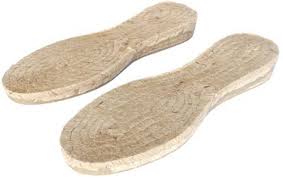
Esparto soled
The espadrille is used mainly in Spain, southern France and parts of Latin America.
It is believed that the espadrille was originated in Egyptian sandal, which then the Romans were inspired to develop a covered slipper and to protect the foot from the sun and heat. Are documented In Europe, they are documented since at least the year 1322, when a document written in Catalan describes espardenyes 'espadrilles' and mentions its current name in Catalan. In Catalan "slipper" is also called espardenya.
Same as, they were used in America, before the European contact. In America, the earliest record of espadrille is a part of a collection of articles from the Chaco region (Argentina), in the twelfth century.
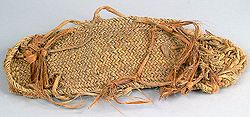
Espadrille from Chaco (a region of Argentina) in the twelfth century
Both Uruguay and Argentina, it is adopted by rural workers to replace the boot rack. Unlike other garments , the humble espadrille became a ubiquitous garment for both sexes but especially in the inseparable companion of her baggy trousers. Useful for those who could well serve long journeys comfortable footwear, since it was used as an ally of days under the summer rain by peasants and accompanied the rhythmic tread of the popular dance. Has currently been for cultural , clothing garments laborers or profane acts, the espadrille has become cheap shoes and everyday of the gauchos and countrymen ; although it is common to use this comfortable and lightweight footwear by most of the population, when they are on vacation, in warm areas. Espadrilles entered the Argentine political scene in the run-up to presidential term of Juan Domingo Peron, when they were tied with the working class. In 1943 and 1944, the student movement opposed Perón and labor unions, that supported his actions , began using the slogan "no to the dictatorship of the sandals”, which was in turn responded with the slogan "yes espadrilles, not books". In the first half of the twentieth century, it was so common to use sandals among the lower classes of the population, that it became very importance the company called “Factory Alpargatas Argentina”, which is used to promote art, with wall calendars illustrated by Florencio Molina Campos.
Specifically in Spain, it was particularly widespread use in the territories of the former Crown of Aragon (Aragon, Catalonia, Valencia and the Balearic Islands) and the Castilian origin as in Murcia, Almería, Granada and the Basque cultural field (Basque Country, Navarra and the French Basque Country). It is also traditional in Occitania (southern French Country), having its major production center in Mauleon, capital of the Basque-speaking region of France Sola. In Spain, it was also extended as urban worker footwear or even footwear for soldiers, and today it is commonly used as a casual garment in the hottest months, just as in Mexico, other Caribbean countries and in the United States.
In Uruguay and Chile are commonly used in summer to go to the beach or for any outdoor activity. As a fresh footwear, foot stops breathing and it is adapted to the shape of it, being comfortable for various activities.
In Colombia, it is part of the clothing of most costumes, being, in some cases, of sisal or other cocuiza and leather. The inhabitants of the Orinoco River basin, also produce them of animal skin and call them "cotizas" or Cocuizas.
The espadrille is equally used by men and women, although some varieties may have fabric edges and shapes, as well as a "little poppy" in the fabric, contrasting color, to differentiate them from those of universal use. Traditionalists argue that this detail is for the Wayuu indigenous culture of the La Guajira Peninsula, but is alien to dancing tamunangue in Lara, Venezuela, where footwear is typical of women's attire State.
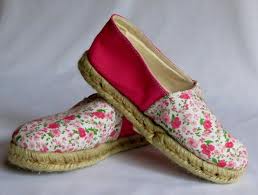 .jpg)
A similar flower than poppy Espadrille with several flowers
In Venezuela it is a very lightweight and comfortable footwear, very appropriate for the tropical climate, used mostly by peasants, but the espadrille is also used in the region of the Venezuelan plains and in many rural areas of the country.
Espadrilles are manufactured using a strong canvas, soled jute or hemp rope. Espadrilles are very light, with good grip on the floor and very thin. Currently its fabric has been industrialized and nylon yarns and rubber sole are used, as well as tarp covers and base cocuiza or other vegetable fiber. The espadrille is woven by hand on looms using triangular homemade wick (“pabilo”) (cotton yarn), combining different colors. The sole can be of leather or cocuiza. It consists of the uppers or Capellá (top that covers the instep and forefoot), "heel" (Talonera) (part forming the arch of the heel) and the "abattoir" (atadero) (also called "Correita”, which serves to hold the uppers to the heel).
This is the most common alpargata (espadrille) and which I love:
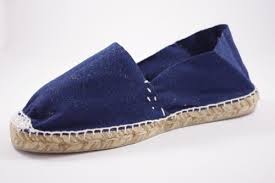
Espadrille with colour dark blue. This is which I buy every year.
Moreover, this (the dark blue colour is my favorite, every summer.
But, you can buy espadrilles of another colours, for men and for women –-they are the same models--:
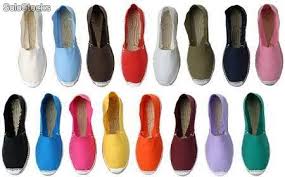
Espadrilles of many colours
But, also exists another model of espadrille, a Little bit different, because this one is stronger, thicker and….a little bit more expensive, logically:
.jpg) 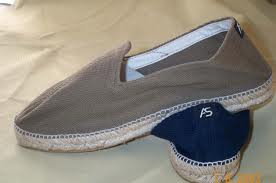
A turquoise espadrille Brown and dark blue espadrilles
There are a variety of types of espadrilles, mainly divided into two classes: those which conform with ribbons and no.
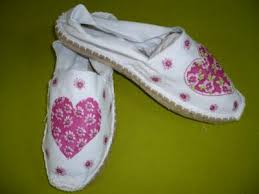
Espadrille with another design
This is the espadrille that I use to buy for my wife –-in black, white and beige colours--:
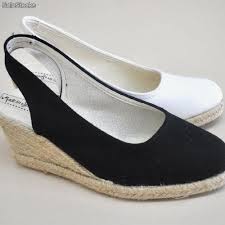
My wife´s favorite espadrille
But sometine I bought this type of espadrille:

Another confortable espadrille, for my wife
Another types of espadrilles with ribbons:
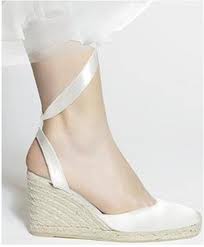 
An elegant model of espadrille Another nice model
You can also split between flat, like traditional, and high heel, which typically incorporate a wedge.
 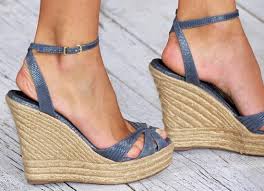
Flat espadrilles Espadrilles with wedge
For example, my wife does not like this type of wedge.
it is now common for soled is wholly or partially covered with a thin layer of rubber to protect from moisture and wear.
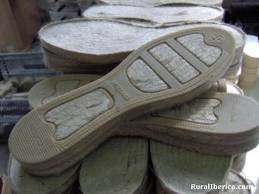
Soles with rubber
But, morevover of espadrilles, there is another type of footwear, made of canvas and rubber. And there are several colours, used above all by young people –boys and girls, from 17 to 25 years old--:




Well, pevenson, I hope I have satisfied your curiosity about non-leather footwear.
If you have another question, I will be happy to clarify it for you.
Till soon, kind regards,
Luis.
Sponsored by Costaluz Lawyers.
Please click down here:

 0
Like
Published at 4:56 PM Comments (0)
0
Like
Published at 4:56 PM Comments (0)
The acidity of the waters of the Tinto River in southern Spain
Thursday, April 24, 2014
If you anytime come to Andalusia, I recommend you coming to the famous “Mines of Riotinto”, its mining Museum and, for that matter, give yourself a ride on the tourist train.These Mines are in Huelva (South western Spain).
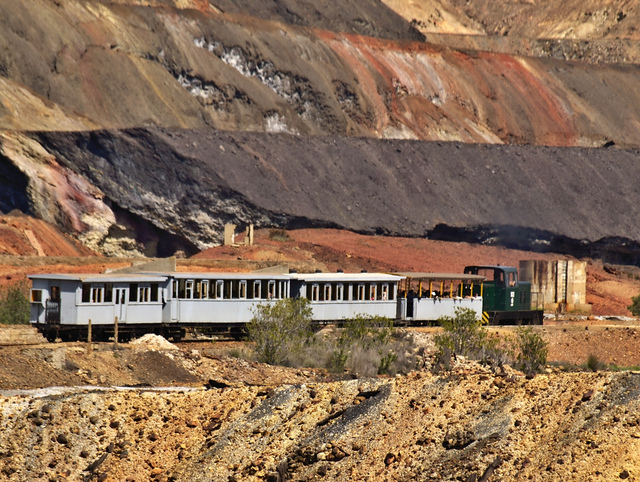
Minas de Riotinto by Jose Maria González-Serna, at flickr.com
You will visit some of the famous open mines, where not long ago they were extracted various metals, especially copper.
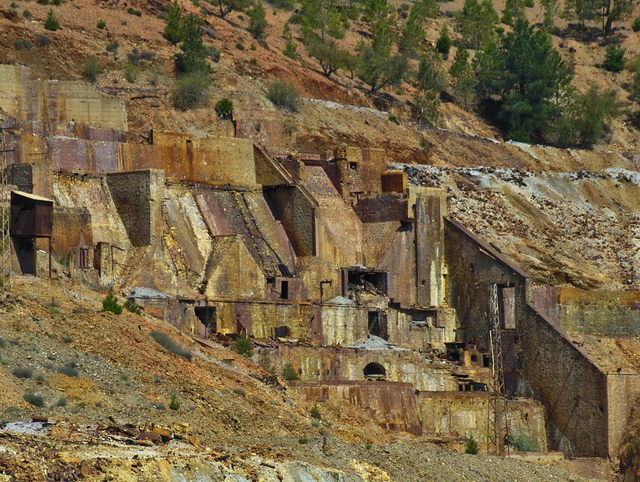
Instalaciones mineras, by Enrique Hinojosa Rosado, at flickr.com
The Tinto river water, which passes through the same municipality, where the mines are located, is reddish in color, very acidic, and until recently, it was thought that mining had much to do in this process.
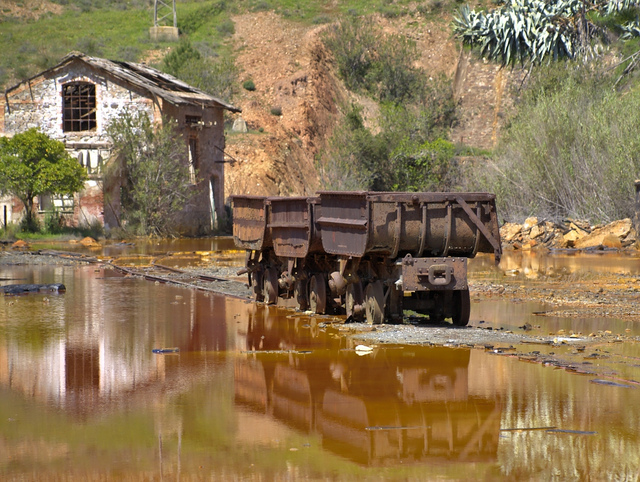
Vagonetas, by Enrique Hinojosa Rosado, at flickr.com
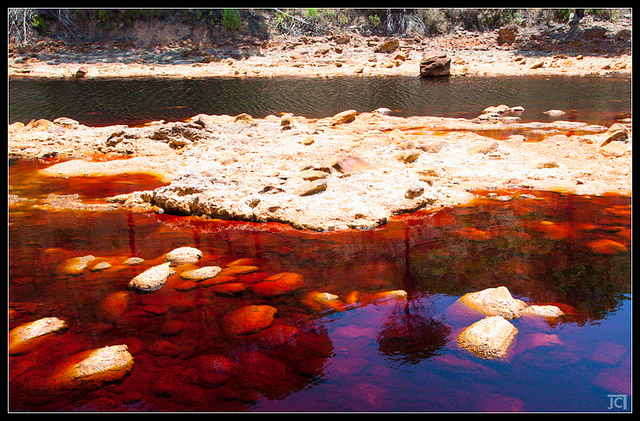
El arbol rojo / The Red Tree, by Jose Carlos, at flickr.com
The origin of the acidic waters of the Tinto river is mainly due to the interaction of groundwater with different geological units, containing significant amounts of massive sulphides.
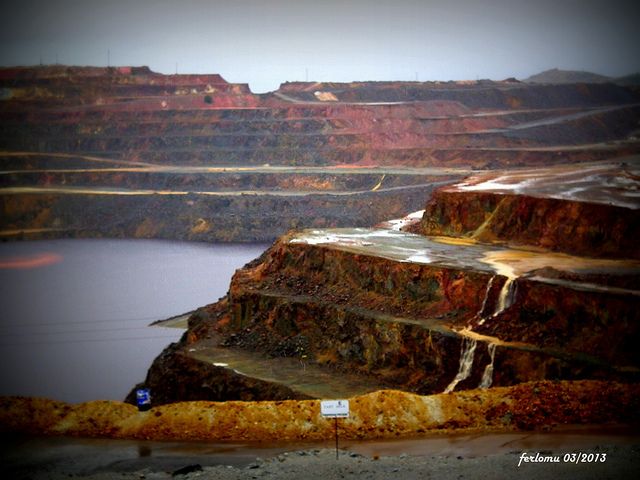
Huelva - Minas de cobre de Riotinto_2, by Fernando Lopez, at flickr.com
This has been demonstrated from studies conducted within the project “IPBSL” --English acronym for Life Detection on the Surface of the Iberian Pyrite Belt--, by the group of research of the Center for Astrobiology INTA-CSIC. The result has been published in the journal Earth and Planetary Science Letters. The Iberian Pyrite Belt is a geological structure, that extends by itself from the southwestern region of the Iberian Peninsula. It is an area rich in all kinds of minerals, mainly pyrite.
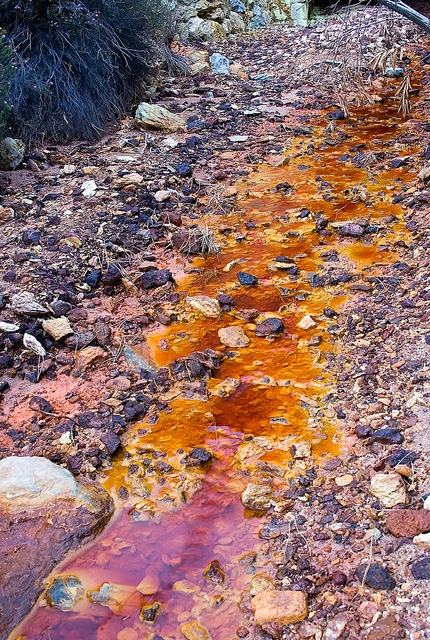
Nacimiento de Riotinto VI, by Xavier, at flickr.com
In fact, it is an area of intensive mining since at least 5,000 years ago. In the province of Huelva, there are over 200 mines, almost all non-operating. This has dramatically changed the field, creating a landscape with extraterrestrial appearance.
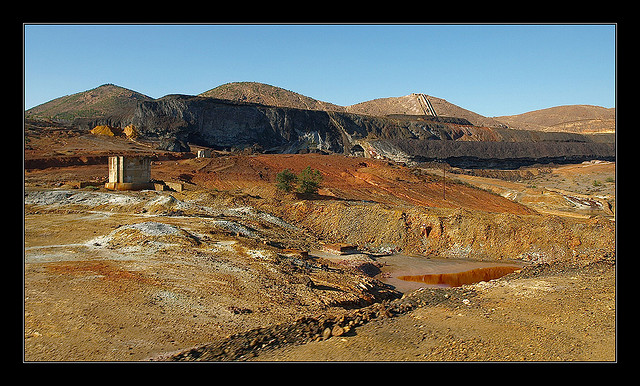
Minas de Riotinto, by Jose Maria Gonzalez-Serna, at flickr.com
In this area, is born the river Tinto (Red River), a river of water stained red by the high concentration of iron oxide, which gives it its name. These results imply that mining has a very limited influence on the generation of acidic waters of the Tinto river, contrary to currently established, which has implications of indisputable environmental interest.
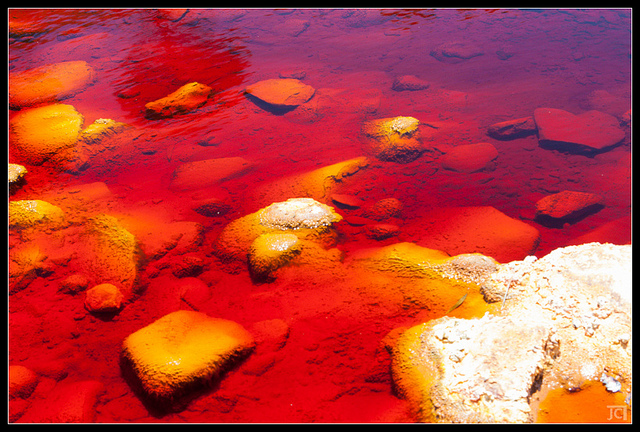
Agua roja / Red water, by Jose Carlos, at flickr.com
Well, I hope that you can come to visit this such spectacular place.
Till soon, kind regards,
Luis.
Sponsored by Costaluz Lawyers.
Please click down here:

 0
Like
Published at 11:53 AM Comments (0)
0
Like
Published at 11:53 AM Comments (0)
Discovered in Spain cells of fish resistant to viral infections
Tuesday, April 22, 2014
Viral diseases are a major threat to aquaculture and hence the effort to deepen the understanding of the immune system of fish and the development of more effective vaccines.
In this sense, the group of “Fish Virus” of Luis García-Pérez Estañ, from the Institute of Molecular and Cell Biology, in the University Miguel Hernández of Elche (Alicante, East of Spain), is studying how cells respond to viral infection, according to the program of RNE “Between Cylinders”.
Specifically, they research situations in which the cells, instead of being destroyed by the virus, are able to survive resulting in what is known as “persistent infection”.
It is very interesting that these cells, carrying the virus, are resistant to reinfection by a second virus different than the first one.
The curious thing about these cell cultures, which we call carriers, is that only a few cells seem to be really infected, but that is enough in order that the whole culture is becoming resistant.
Thus, there is evidence that the carrier culture provides to medium an antiviral factor, with the properties of interferon, which affords protection to other cells of the same type against the viral infection.
It is currently being studied whether this phenomenon is generalizable to different fish species and how broad --ie how many different virus-- is that resistance to superinfection.
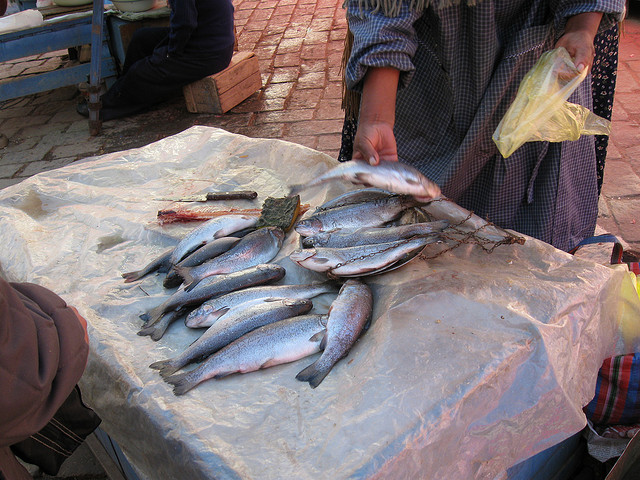
Trouts, by Alhen, at flickr.com
As for applications, they are still preliminary studies, but whose final objective is the improvement of vaccines, trying to bring them the nonspecific component protection, broad spectrum, as well as resistance, to a specific pathogen, itself of such vaccines.
Well, I hope that they follow researching, in order to eliminate another diseases.
Till soon, kind regards,
Luis.
Sponsored by Costaluz Lawyers.
Please click down here:

 0
Like
Published at 11:48 AM Comments (0)
0
Like
Published at 11:48 AM Comments (0)
Aracena: A roman village in the south western Spain
Thursday, April 17, 2014
It is located in the north of the province of Huelva, 104 kilometers from the capital, 800 km from Seville and a height of 700 meters above the sea. It is a white village, immaculate by the state of their houses and streets, wherein low rise and whitewashed houses, built with an Andalusian style and where the grates are not lacking for decorating facades. Stoned limestone soil are found in almost all the village. It has grown in the last years and that has transformed some parts of the town, where 6,600 people are counted.
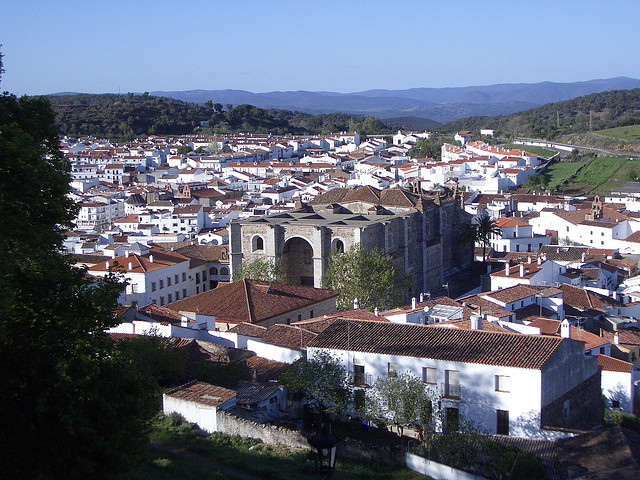
Aracena desde el castillo, by icases, at flickr.com
Aracena is the tourist center par excellence, in the mountains north of Huelva, therefore its main attractions include the Cave of Wonders or the Church of the Castle, for the many guest houses, where you can enjoy good food and of course , excellent ham. It is also a good place, for shopping, mainly crafts and antiques.
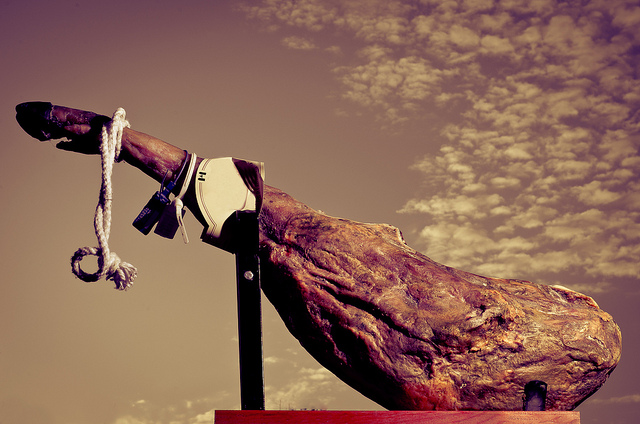
Jamon de Huelva by Jesus Belzunce Gómez
There is not a very precise documentation of the origin of Aracena, to determine its history; although most sources agree that this is a Roman settlement. According to the formation of the name of Aracena, this one would mean that it was the property of someone named Aretius or Arcius.
Aracena was for centuries a place of border disputes and altercations between troops from different armies. In 1251, the troops of Alfonso I of Portugal expelled the Arabs, restoring the city to the Kingdom of Portugal. After some years of disputes, between Castile and Portugal, for dominance of the region by the "Treaty of Badajoz", in 1267, it passed to belong to the Castilian kings. Alfonso X gave the city to the Templars, under whose jurisdiction in 1312. En remained until 1649, becomes dependent on the Count Duke of Olivares and, in the eighteenth century, the Count of Altamira. The nineteenth century would bring new war events, due to the French invasion and the War of Independence.
In one of the nearby mountains, called "The cock crows", it took place one of the bloodiest battles, in recent memory. Aracena was declared city, officially in 1901, by the Queen Regent. In the last decade has been very important, for the local economy, the tourist phenomenon, although it remains current agricultural and livestock tradition.
A walk through the village, you can admire some of popular architecture such as the Muslim houses and streets Trinity Mother and Francisco Rincón; and the stately homes of the second half of the nineteenth century and early twentieth, in the streets Barbers, Constitution, Hope and Campito (little field).
In Constitucion Street is also located a Renaissance house, in the sixteenth century. Also you can see buildings of the "Sevillian School", designed by architect, Anibal Gonzalez, author of the Square of Spain in Seville. For example: the Casino Arias Montano, the Market Square and the Town Hall.
GRUTA DE LAS MARAVILLAS (Cave of Wonders): In Pozo de la nieve, s/n (without number). Telephone number: 959 12 83 55. Horary: There is a pass every hour between 10:30 h. and 13:30 h. In the evenings, also a pass between 15:30 h. and 18:00 h. Guided by groups with a limited number of people visit takes place. You have to wait for the group to be formed to begin the tour. Admission: 8 euros (adults). Discounts for students and seniors . The tour of the Cave of Wonders , the most extensive of Spain, is a foray into the interior of the earth, where you can admire so beautiful underground stalactites and stalagmites and spectacular lakes. It is altogether an extension of 1200 meters and it usually lasts for an hour. The loaded lime water for centuries has dripped slowly and has created the particular formations of this space. Before falling to the ground, leaving droplets carrying lime, resulting in a bizarre landforms. The tour of the cave begins with "Cathedral", which received its name because the formations resemble the vertical tubes of the organs of the Cathedrals. From there, the rooms follow one another, leaving the visitor speechless. “The brights hall ", "The bath of the Sultana" , “The emerald lake" or “The glassware of God" ( particularly interesting, because, in this room, occur the calls eccentrics, similar to stalactites formations but which "grow" in all directions), among others.
CASTLE AND CASTLE CHURCH: High on a hill, from which an excellent panoramic you will make out the village and the whole region, you will find the ruins of the old castle. There are little remains of the fortress. On the contrary, remains in fairly good condition the castle church. This is not a construction of very large gothic production, with three naves of the same height, and it is dated in the thirteenth and fourteenth centuries. Some historians claim that it hosted the Templar order. Attached to the church, there is a magnificent tower, built in the Moorish style, shown in perfect condition. All constructs were declared historical-artistic whole, in 1931.
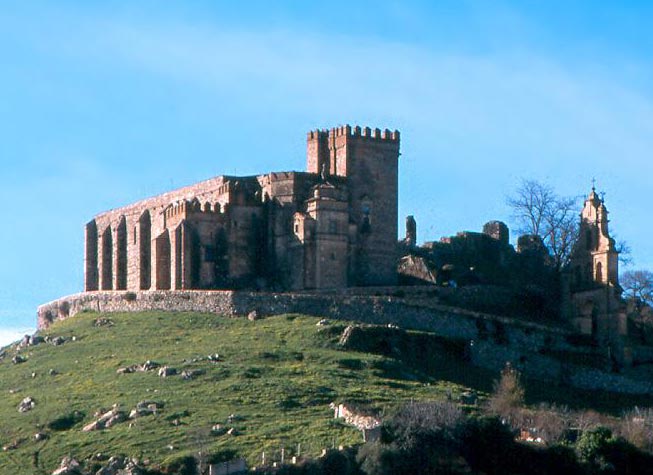
Aracena-Iglesia y Castillo de Aracena, Huelva, South western Spain
OLD TOWN HALL: This is an attractive building, situated in the Upper Square (Plaza Alta), opposite the parish, on the road up to the castle. It was formerly the Town Hall. It was built between the XIV to XVI centuries. Currently conditioning, is one more network information center of the Natural Park.
CHURCH OF ASSUMPTION: Also in the Plaza Alta, the church of Nuestra Señora de la Asuncion, in Renaissance style, was built in the sixteenth century. Its aspect, at least seeing it from the Plaza, is a real square mass of stone. It is assumed that during construction, the project was supervised by the same Juan de Herrera (the architect of the monastery of El Escorial, Madrid).
CONVENT OF SANTA CATALINA: Plaza de Santa Catalina. This building of the fourteenth century, Mudejar, was an ancient Jewish synagogue, then cloistered convent. Inside there is a baroque altar. Today belongs to the Carmelite Mothers and this asset: the cloistered convent rich developed handmade sweets.
CASINO ARIAS MONTANO: Street Marques de Aracena. In the colorful main square of the city, the most prominent building is the Casino, with modernist style and built in 1910. It is a work by the architect Anibal Gonzalez, who apparently was inspired by the Austrian modernism. Its function was to provide a place of recreation for the more affluent sectors of the early twentieth Aracena. Was built, shortly after, another building of similar function, but for the lower classes in the same place: the Casino Workers. It is at number 7. It also existed a Casino Craftsmen, burned during the Civil War, for that guild, which constituted the middle class at the beginning of the century.
CHURCH OF EL CARMEN: Street José Nogales. The Church of el Carmen is Mudejar style and dates from the fourteenth and fifteenth centuries. The belfry is back, as it responds to the neoclassical taste.
HAM MUSEUM: Street Gran Via. Phone: 959 12 79 95. museodeljamon@ayto-aracena.es.. Horary: Monday to Sunday, guided tours every 40 minutes between 11 and 17 hours, approximately. Attendance: 3 Euros (adults), 2 Euros (under 18) or 2.5 Euros (over 65 years).
The new attraction of Aracena is this fantastic museum, dedicated to the most celebrated product of the Sierra de Huelva: The Iberian ham. The museum, which is a guided visit, reviews all aspects of the culture of ham and pork in general, in the area: history, geographical and climatic conditions, elaboration of ham ..... It is a very well thought out and conditioned Museum, with an audiovisual projection and modern and didactic panels, that provide insight really fun facts, quoted this product. It is a must visit.
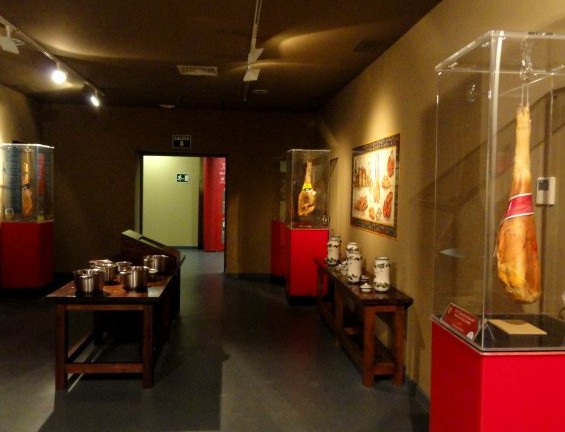
The Museum of Ham, Aracena, Huelva, South western Spain
Here you have three recommended excursions:
FUENTEHERIDOS: Road to Jabugo from Aracena to the left of the road, it passes through this village, now living mainly thanks to fruit. At the entrance of the population, you can see a marble cross seventeenth century; Once in town, you have to come to its source 12 pipes near there, in the square of El Coso, you can be one of the oldest inns in the area, all the old area of Fuenteheridos is considered historical and artistic set. The most prominent landmark is the church of the Holy Spirit, the church tower (XVIII century) is a curious one, with square floor and built of brick, it is topped with a pyramidal roof of ceramic. From 1 km, in the direction of Portugal, are the Botanical Gardens of Villa Onuba, designed early in the century by the German Guillermo Sundheim, with over 100 different species of trees.
CORTEGANA: Situated 100 km from Huelva, between Aroche and Jabugo. Cortegana is the second population of the mountain and is a town of white walls, with narrow cobbled streets, including old houses remain. Stresses especially its castle high on a hill, with magnificent views of the town and the best preserved of the entire province. As part of the urban core, the Church of the Divine Savior, Moorish building of the first half of the fourteenth century and the chapel of San Sebastian, Gothic-Mudejar also known as "The Saint".
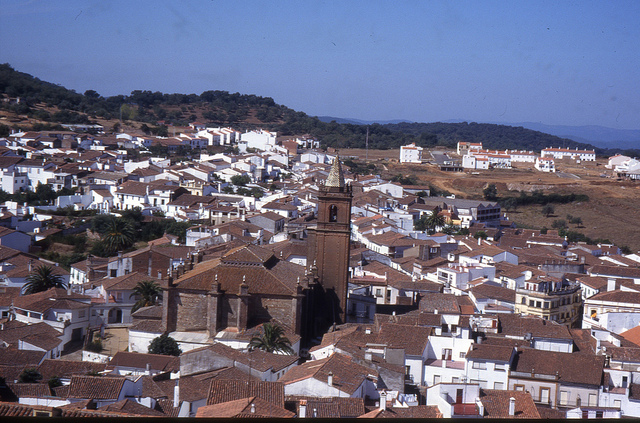
Cortegana, by CLUB DE AJEDREZ LINEX_MAGIX, at flickr.com
NATURAL PARK SIERRA OF ARACENA AND PEAKS OF AROCHE: With an area of 186,000 hectares, extending on the western edge of the Sierra Morena, north of the province, bordering the provinces of Badajoz, Seville and Portugal. Regarding vegetation, we must stress the importance of oaks, oak groves, whose exploitation has led to the area, a major source of income, either through the cork or exploiting the abundant pastures and acorns, for breeding pigs. As for animals, we must mention the presence of golden eagles, driveways, snakes and Bonelli, and black vultures, kestrels, storks, mongoose, lynx, genets and otters.
Now, I want to show you some lodgings of rural tourism:
HOUSE IN THE COUNTRY LA SILLADILLA: Road Los Romeros, Jabugo Telephone number: 959 50 13 50. Fax: 959 50 13 51. www.silladilla.com silladi@teleline.es .It is located in the village of Los Romeros, in the heart of the Natural Park of the Sierra of Aracena and Peaks of Aroche, near Jabugo. Placed in a fantastic estate of 130 hectares, with springs, trails, much woodland, it is a rural hotel, which has been restored several farmhouses, it consists of a main building, which houses have 11 rooms, with terrace and all comforts: air conditioning, heating, television, minibar and bathroom with tub. And common shares as a living room with fireplace and a conference room for 20 people. And full rental houses. Each house has a different color and furniture, decorative touches successful among them bronze fixtures, huge pieces of mahogany and chestnut, Portuguese ceramics and antique furniture. Each accommodation has a garden, walkway, barbecue and separate outdoor parking.
The offer is completed with 2 outdoor pools, one with Jacuzzi and jets of air. Delicatessen shop and a little bar. But it has no restaurant service. Only breakfast is served in the rooms.
HOUSE IN THE COUNTRY VALBONO (H ***): Road Aracena-Carboneras, km 1. Aracena. Telephone number: 959 12 77 11. Fax: 959 12 75 76. valbono@wanadoo.es Located in the Sierra , amidst a forest of chestnut trees and cork oaks and 1 km from Aracena, in an area of great ecological and surrounded by a large estate value. The hotel consists of a main , liming and modern building with the typical Andalusian building, 3 cottages and 14 farmhouses. It has very good sports facilities, conveniently separate accommodations. The hotel has 6 double rooms with heating, bathroom, telephone, air conditioning, living room with fireplace and terrace. The farmhouses have a kitchen, bathroom, fireplace and separate exit and are decorated in rustic furniture. In addition, there are 3 buildings targeting groups accommodation hostel type. Jardin. Terrace. Pool. Bicycle Rental. Equestrian Centre, where there are riding lessons. Football field. Tennis Court. Padel. Volleyball. Parking. Service à la carte restaurant, predominantly related to the Iberian pork, mushrooms and some dishes like oxtail and tripe dishes. Good traditional desserts.
HOTEL GALAROZA SIERRA: Road Sevilla-Lisboa, km 103. Galaroza. Telephone number: 959 123 237. Fax: 959 123236. www.hotelgalaroza.com información@hotelgalaroza.com . Located in the town of Galaroza. The hotel is a modern, comfortable, air Andalusian building and several houses rustic decoration and mountain, located in the hotel grounds and spread over the hotel grounds. It has 2 single rooms, 17 doubles and 3 triples; all with bathroom, telephone, TV, heating and views of the Sierra. It also has 7 small bungalows or mountain homes with separate access, located beside the pool and have one bedroom or two bedrooms, both with ensuite bathroom with bath, air conditioning, satellite television, telephone and fireplace. The hotel has a lounge with TV and quite another wider, where you can plan from a business meeting to a celebration for 100 people. Cafeteria. Terrace. Barbecue. Gardens. Pool. Parking. Handicapped access. Pets are allowed, only in bungalows. It has a typical restaurant called "The Oaks Forest", where they offer typical local specialties such as stew, mainly consisted of potatoes, pork ribs and liver stew.
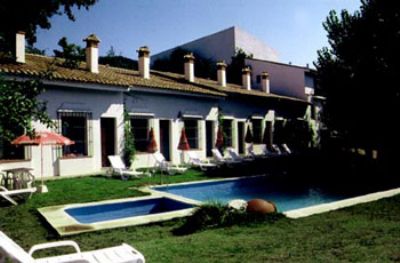
Hotel Galaroza Sierra, Huelva, South western Spain
HOUSE IN THE COUNTRY GOOD WINE (H*): Deviation of the N-433 Marines. Telephone number: 959 12 40 34 Fax:. 959 50 10 29. Look for information, because it does not open all year. 7 km from Aracena. Attractive and small rural type accommodation with a warm and cozy decor. It has five bedrooms, with separate bathroom. In the same building, there is a small rental house in the middle of a forest, with three bedrooms, bathroom and fireplace .. The price includes breakfast. The property has a swimming pool.
THE PATIO: A cottage, situated in the urbanization San Roque. Telephone number: 959 12 89 94.The house, run by Maria Jesus, adds two bedrooms, a bathroom, kitchen and patio.. It's simple, but it's pretty good.
RESTAURANTS:
The local cuisine is a compendium of dishes derived from iberian pork products, from vegetable garden and forest areas, with great wealth and mycological resources such as nuts and game meat. Popular cuisine is represented in stews such as mushrooms and chestnuts, garlic soup, gazpacho winter, slaughter and crumbs broth. The range of restaurants is concentrated mostly in the vicinity of the Cave of Wonders, but if you get to Aracena, in low season, it is likely that, at night, no restaurant open is found, because which you can find near the cave, only open at noon.
CASAS (HOUSES): Beside the Cave of Wonders . Telepkone number: 959 12 80 44. It is a small restaurant, with a rustic and typical decoration of the mountain, but kept detailed. It is one of the first restaurants, which ran across this region. It opened in 1948. Then, It had five tables. In 1958, supply increased and could serve 12 tables. Everything was a result of the initiative of a German, who envisioned decades ago, the tourist potential of the mountain and opened a kind of inn, in the area, and then it derived in a restaurant, which would be installed in Aracena. It is a nice and cozy home. The hams, hanging from the ceiling, remind us in which region we are. Manuel Romero , the owner, directs thirty years and boasts remain vigilant in regard to quality. Among the specialties, we must not lose sight of the loin stuffed with ham, baked, and marinated dam palette . Alternatively, rabbit and partridge. For dessert, there would be highlighted chestnut soup, quince compote and homemade custard.
MONTECRUZ: Telephone number: 959 12 60 13. A cafeteria, on the ground floor, passing the restaurant (above), where is an extensive menu of local dishes offered.
JOSÉ VICENTE: Avenue of Andalusia, 53. Telephone number: 959 12 84 55. Closed on Friday and the second half of June. It is the paradise for lovers of iberian pork derivatives: mushrooms, in season, receive special treatment. Other dishes: lamb stew, vegetables with ham. Handicapped.
ARRIEROS (Mule drivers): Street Mule drivers, 2. Linares de la sierra. Telephone number: 959 463 717. 8 km from Aracena, in the quiet village of Linares de la Sierra.
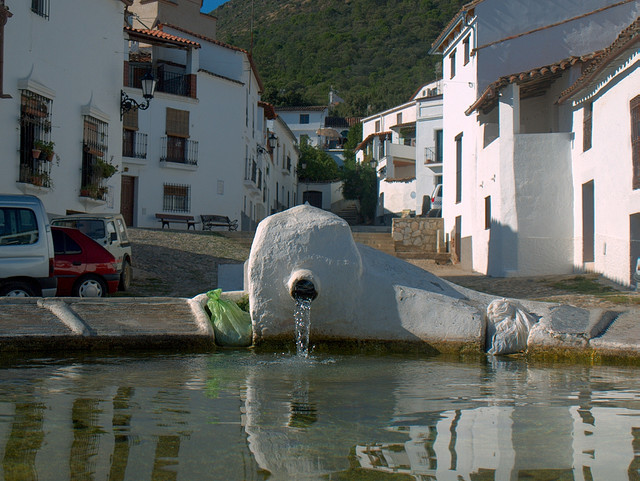
Fuente de Linares de la Sierra, by Enrique Hinojosa Rosado, at flickr.com
The gastronomic offer revolves around the Iberian pig: pig's trotters, lane iberian pork, iberian pork pâté, prepared in an original and engaging way. It open only for lunch noon.
LA RÁBIDA: Street Los Chops without number. Telephone number: 959 12 62 20. Establishment without any ambition, which is, however, highly recommended for its good home cooking stews and especially for their prices.
Well, I hope that you can come to Spain and, concretely, to this area. You will be welcome.
Till next time, kind regards,
Luis.
Sponsored by Costaluzlawyers.
Please click down here:

 1
Like
Published at 6:18 PM Comments (3)
1
Like
Published at 6:18 PM Comments (3)
The European Commission reviews the Spanish Science
Saturday, April 12, 2014
A team of experts from the European Commission (EC) has been discussing, during the 9th and 10th of April, the situation of R + D + i through the Spanish called “European Research Area Committee (ERAC) peer review”, as reported by the Minister of Economy and Competitiveness, Luis de Guindos, in the Senate.
The group of nine experts from five countries of the European Union (Belgium, Germany, Estonia, France and Sweden), four independent and two representatives of the EC, has held meetings with representatives of the Spanish R + D + i. Its recommendations, according to the minister, "they will serve the implementation of the Agency for Research and improve our system of science as a whole", as SINC collected.
The visit took place at the initiative of the Ministry of Economy and Competitiveness and aims to improve support tools for R + D + I, to respond effectively to the needs of industry players (researchers, universities, public research centers form and companies), said this organization, in a statement.
This initiative aims to ensure that carried out the objectives of the Spanish Strategy for Science, Technology and Innovation, adopted in February 2013, by adopting measures, reforms or adjustments required to strengthen the effectiveness of the system Spanish R + D + i.
On April 9, the experts were received by the Secretary of State for R + D + i, Carmen Vela. They then conducted a series of interviews with representatives of government, both the Central Government and the Autonomous Communities.
On Thursday 10 April, the European expert group met with representatives of the public research centers and research institutes, universities, researchers and companies, just like associations and technology centers.
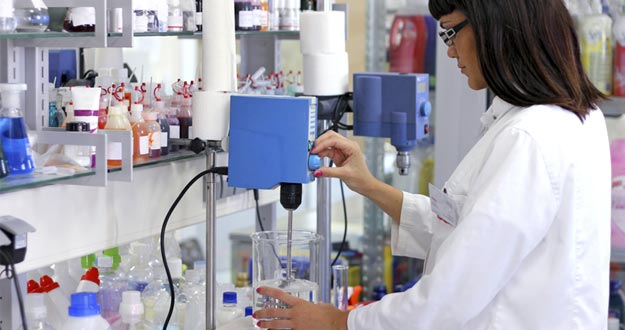
A Chemical lady in the laboratory
It is expected that these interview sessions continue next June, when the broad spectrum of agents, that make the system complete, indicates the ministry.
"The conclusions of the experts and their indications, --added these sources-- contain a great value, since they rely on the experiences, that they have had in each of their countries and of specific measures that have been implemented and evaluated".
The ministry will report findings in the coming months and will include the recommendations in the National Reform Programme of the Government in 2015. "All the Autonomous Communities will participate in this exercise, which may prove very useful to increase collaboration, seeking greater synergies and eliminate duplications and dispersions in the field of R + D + i. The government is particularly proactive in this sense, so maintaining a dialogue with the CCAA", concludes the institution.
I hope that Research and Development in Spain follow been good, for Europe and for all the world.
Till next time, kind regards,
Luis.
Sponsored by Costaluz Lawyers.
Please click down here:

 0
Like
Published at 7:07 PM Comments (0)
0
Like
Published at 7:07 PM Comments (0)
A new study on Alzheimer in Spain
Friday, April 11, 2014
A new research, at the University of Valencia (East of Spain), has discovered eight new molecules, which fight Alzheimer.
Researchers, at the University of Valencia (UV), have discovered eight new active molecules against Alzheimer, delaying some of the determining processes, in the development of the disease and follow a novel mechanism of action, different from those of drugs currently in use.
The research results, published in the open access journal “Plos One”, reveal that the molecules have been designed following a mechanism involving inhibition of the deposit of the beta-amyloid protein, which is responsible for the appearance of the disease.
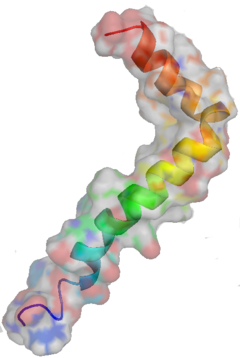
The Beta-amyloid protein
The mechanism also inhibits the formation of small protein fragments, called oligomers, which arise in the early stages of the disease and seem to play a determining role in the development process, says the UV in a note.
The Director of the team Team of the Unit Drugs Design and Molecular Topology of the UV, Professor of Physical Chemistry, Jorge Gálvez, specifies that the molecules have been designed "by following a methodology called molecular topology, in which the group works since early the 80" and which allows describing and predicting the molecular structure of some chemicals.
The laboratory tests, that have confirmed the activity of the new molecules, have been conducted in the School of Medicine “Mount Sinai” of New York. In them, the molecules have been shown to be active both in vitro --in neuronal cell culture-- like in vivo, --in transgenic mice--.
The professor of Neurology and Director of the Center of Excellence for complementary treatment of Alzheimer of the “Mount Sinai”, Giulio M. Pasinetti, has directed the trials, in which have also participated Japanese and American researchers.
The group of Drugs Design and Molecular Topology of the UV has worked in the design of many other types of drugs, including anticancer, analgesics, antihistamines, new food additives or pesticides, under the direction of Gálvez and García-Domenech teachers.
In this sense, they have been authors of over one hundred scientific publications on the subject in international journals, as well as several national and international patents.
According to Jorge Gálvez said: "This shows once again that the molecular topology is a powerful tool for the design of new drugs and in general of new active molecules, in various applications, including agriculture, food, etc..".
The Alzheimer, in Spain, affects to 600,000 people, according to the Spanish Society of Neurology (SEN), it is present in one of ten households, and there will be more, because it is expected that the incidence will double, in the coming years by the progressive aging population. However, approximately 30 to 40% of cases may be undiagnosed, especially in the early stages of the disease, when it is milder. There are only five percent of cases diagnosed, according to SEN.
Well, I think this discovery is a great step of hope for such million patients and their telatives.
Till next time, kind regards,
Luis.
Sponsored by Costaluz Lawyers.
Please click down here:

 0
Like
Published at 12:21 PM Comments (0)
0
Like
Published at 12:21 PM Comments (0)
Otero de Sariegos: another small abandoned village in northern Spain
Friday, April 11, 2014
The Industrialization and finding new opportunities in large cities has caused many villages of Spain are empty. They were villages with a lot of life –even though if they were small towns -- and even they had young people; But the years passed and those young people became very elderly, who refused to leave their land. But reality prevailed and those much older people dying or leaving, to the city, to help their children, among other things, with the important work of caring for grandchildren.
One of those villages was Otero de Sariegos, in Zamora, northwest of Spain. As its name suggests, it is a town on a knoll or hillock from where excellent views of the lagoons of Villafáfila and just like the plain where the people of Villarrin de Campos and settle Villafáfila are sighted. ''When we were waiting for a relative, who was delayed a bit, we went to the church wall and from there we could see all the way and saw where it came from''.
 Otero de Sariegos (Zamora), North western Spain Otero de Sariegos (Zamora), North western Spain
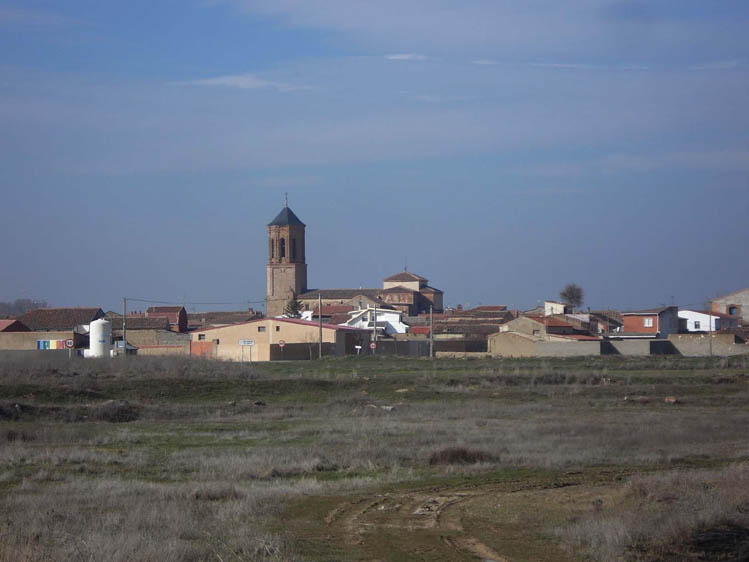 Villarrin de Campos (Zamora) Villarrin de Campos (Zamora)
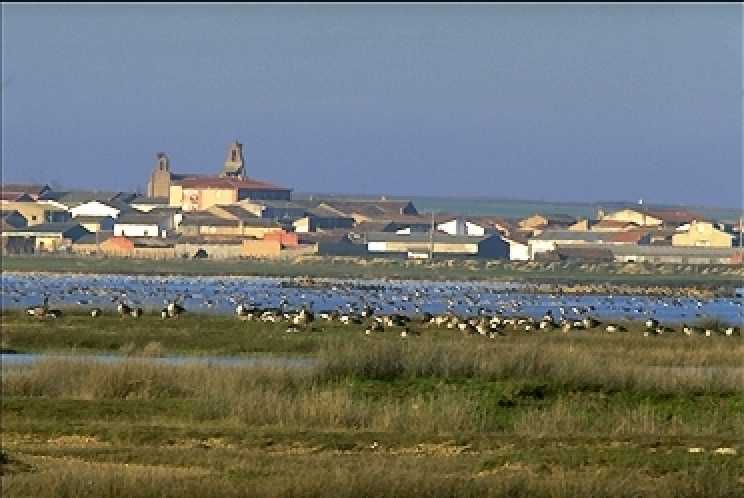 Villafáfila (Zamora) Villafáfila (Zamora)
A nice village and rundown that once numbered about twenty houses. The houses were built of mud and adobe and, as this item carries poorly over time, many of the buildings are on the ground.
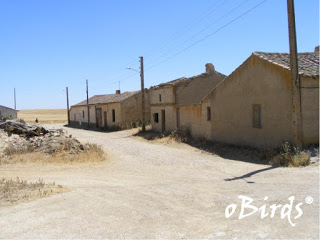
A street of Otero de Sariegos (Zamora)
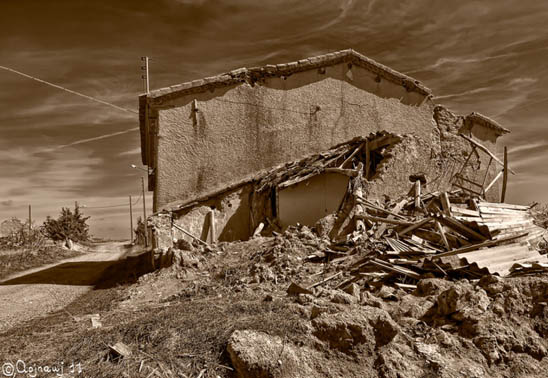
A collapsed house in Otero de Sariegos (Zamora)
Wheat and barley were the main products planted in their fields, while the mules, cows and sheep were the most representative animals in livestock.
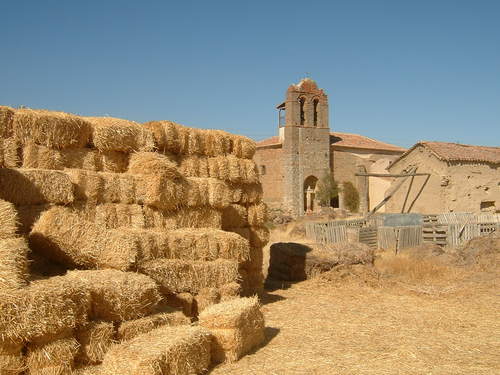
A barn in Otero de Sariegos (Zamora)
Its neighbors were partners in the Association of Farmers and Ranchers Brotherhood to manage and protect their interests. They had the figure of the rural guard who was in charge of monitoring the possible theft and livestock care to not to meddle in farmland and other issues.
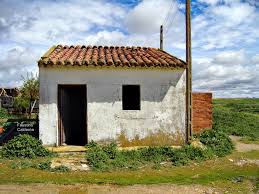
House for the Association of Farmers and Ranchers
They had an excellent farm pasture: Valdecasas meadow, where they carried to graze cattle and mules, which were not used in farm work. The cowboys played a cowbell in the morning through the village, so that the neighbors were taking their animals out. Miguel, from Villarin de Campos, and Julio, from Villafáfila, exercised this trade of jean for years in Otero de Sariegos.
.jpg)
A good farm pasture closed the lagoon
They celebrated their patron saint on April 25th (San Marcos). The firing of rockets and fireworks heralded the beginning of the party, where the mass had a great prominence, spectacular with some great songs, that put you a goosebumps. It was taken in procession to the Virgin through the streets of the village, with women being responsible for carrying the litter. The dance was performed in the afternoon and night, always inside a building as was the ground floor of the Ojero´s house to some panera (a rural building on stilts to keep the cereal) or some well-conditioned corral. The music was provided by an organ, that brought the brothers from Santacirila de Villafáfila; in more recent years, it was replaced by a turntable.
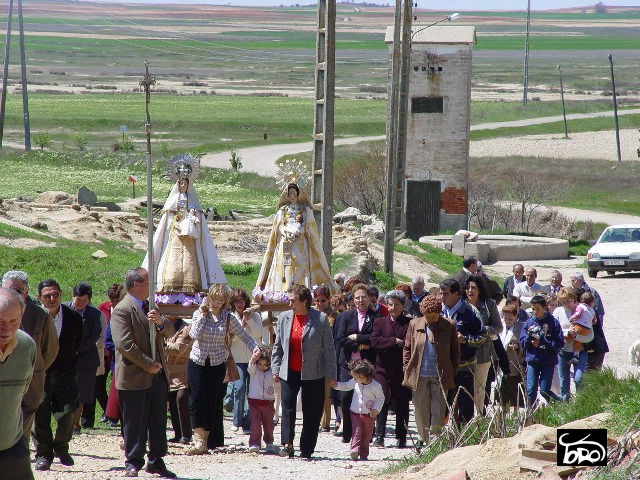
The procession in Otero de Sariegos
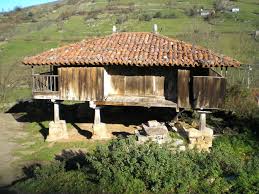
Panera
That day, a special food was cooked in the houses; but the star dish was the rice pudding prepared for the occasion, that had a lot of fame in all villages around.
Villarrin de Campos and Villafáfila were the villages where more people came to join the festivities.
On November 11, for San Martin, had a party again, but this time there was no procession.
The priest always came from Villarrin de Campos. Every Sunday was celebrated mass. Don Julian, Don Abdon, Don Agustin or Don Arcadio were some of the pastors who came to perform such an act.
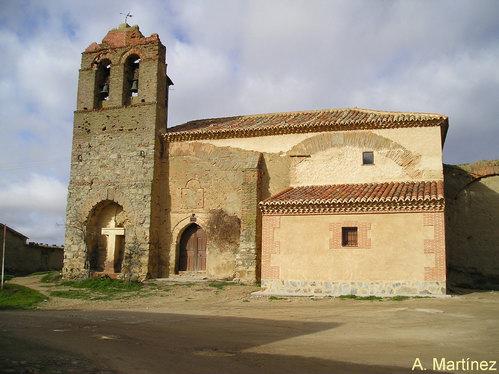
The Church of San Martín, Otero de Sariegos (Zamora)
The doctor (Don Daniel) came from Villafáfila; they had to go looking for him with a cavalry, in order that he displaces to Otero himself to visit the sick.
Agustin Miñambres, the mailman, came twice a week from Villarrin de Campos to bring all correspondence and even charged the pension, that the seniors wore too.
Theophilus, the barber, came from Villafáfila to cut hair in the houses, where he was requested.
They were going to grind grain to factory of flour of “La Tabla”, where they gave wheat and returned them the equivalent in flour.

Factory of flour, "La Tabla"
The busiest day in Otero de Sariegos was Thursday, that was the day market, in Benavente (Thursdays from Benavente), it was customary for the people from Otero and all the peoples of the region to go that day to Benavente, to sell an animal, to purchase products or just for spend the day, although they did not make anything special. They had to wake up at two in the morning to walk the eight miles that separated them from the railway station of La Tabla and take the train to Benavente. Years later had a car line, that came out of Villanueva del Campo and gathered the people of all the villages of the region to move them to Benavente. The people from Otero also had to get up early because they had to be at the junction of the road, at eight in the morning, when the carriage passed.
To a lesser extent they also went to the markets of Zamora (Zamora twelve) by the same means of transport.
Always products and all kind of necessaries were purchased the day when they went to Benavente; but they moved to Villarrin de Campos and Villafáfila, where they had a trading, to make simpler shopping.
And the peddlers were responsible for bringing products, that Otero had not in the village, as they were the Toresanos, who with a mule cart in roping (a mule in front of the other, not both in parallel) they had peppers, tomatoes, onions, etc.. With a cart appeared another peddler from Villalba de Lampreana, who went selling rice, oil, sugar ...
When they had a road, a seller from Villafáfila went, with vehicles of the time, selling utensils and furnishings as the famous Duralex plates, so popular these years. The first time that he brought them, he sold everything in a heartbeat, because they were the novelty, but Francisco Montero recalls a funny story that took place that day:
“As it was a new, the man came boasting plates and they were unbreakable, he let them fall to the ground slightly and they did not break, the grown man with his show, grabbed a plate and rose into the sky above heads, falling to the floor plate was shattered. The good man did not know where to get the laughter and ridicule of the women who were there buying''.
Usually every home used to have its furnace, where apart from the delicious bread, were prepared pastries and muffins. Years later they allowed to bake bread and it was brought by the baker of Villafáfila.
The youth moved on Sunday to Villarrin de Campos or Villafáfila, where there was dancing and theater, in both villages, ''We were going to one or the other one, depending of the love interest or friendship, that we had at the time'', apostille Francisco Montero.
In the early 60s, there was a resurgence in the life of people, with two events, that made life easier for the people from Otero: the arrival of the road and electricity.
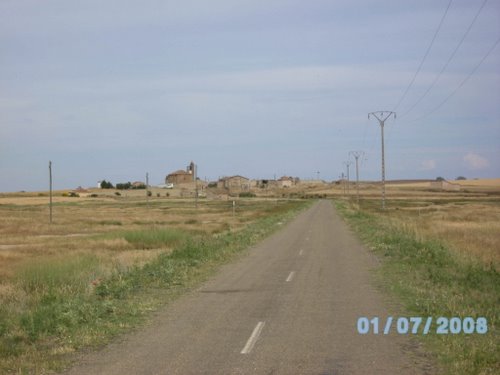
The road and electricity in Otero de Sariegos
These facilities came when Don Ignacio Montero was Mayor of Otero de Sariegos.
The light was a novelty and it replaced the oil lamps of carbide, which the people of Otero were lit at night.
''It was brought from a power plant, that was in Aspariegos, property of Aquilino Gato; it cost 25,000 pesetas the bringing, that was in October of 61'', Francisco Montero recalls.
The other breakthrough (the road), was very necessary, because before it was a trail and put impracticable in winter, cause of mud and water, because there were many wetlands, and sometimes you could not go ahead.
“About the year 60 the construction of the road started by a contractor from Salamanca, Ramiro Gullón , it was a mile long and half a mile it became a pickax and shovel. It cost 63,000 pesetas. The work was stopped for two years. It had been already built a mile , but a quarter mile before reaching the village, the road was to occupy a part of a farm next, to what the owner objected. The road remained stagnant here. There was a trial and the council lost it , so to pay the costs and delays, they had to parcel out in parts of the prairie Valdecasas and each neighbor to lease a plot to bring there livestock so they can cover the costs of the trial. After a time, the good lady , possibly with remorse of conscience for the damage caused to the people with his refusal, she gave permission for the road could go through their land and gave final approval of the work'', said Francisco Montero.
Although the early 60s were good years for the village, even got to know the phone when it only had two open houses, not so with the 70s, this decade saw a major departure from neighbors looking for a better quality of life.
Villarrin de Campos and Villafáfila absorbed almost equal to the people from Otero, who went out of the village.
The solution of the municipality of Otero de Sariegos, because the village was eroding much of the population, was the beginning of the end for Otero. The neighbors, who stayed there, choosed by voting to be incorporated into the municipality of Villafáfila. The Brotherhood of Farmers was integrated into Villafáfila, land consolidation was made, so the neighbors, who stayed there chose to go to the two nearby villages, where there were more facilities and better services and from there they could keep it going to work the land of Otero. If you add the lack of water in homes and the closure of the school, you will understand the twilight of Otero de Sariegos.
Yet two persons held a breath of life in the village, until a few years ago.
So it is told by Francisco Montero: “When we all checked, stayed on one side Maria, who was a widow and, on another side, Porfirio Alonso, who was single. While Mary in recent years she spent time in Villafáfila and another time in Otero, she was not continuously there and, however, Porfirio lived the whole year in the village, so you can say that Porfirio was the last of Otero de Sariegos. He was a man of over eighty years, living without water at home and a little bit insecure. He went out of Otero, on November 21, 2003. The last afternoon, I was with him in Otero, I talked a bit with him and he reported me it --¨ The next day in the morning, I leave, I have never left Otero rather than go to military service, but with a great regret I will not be right back ever--¨. Word that he has fulfilled, because Porfirio, almost 95 years old, is living in the residence of Benavente''.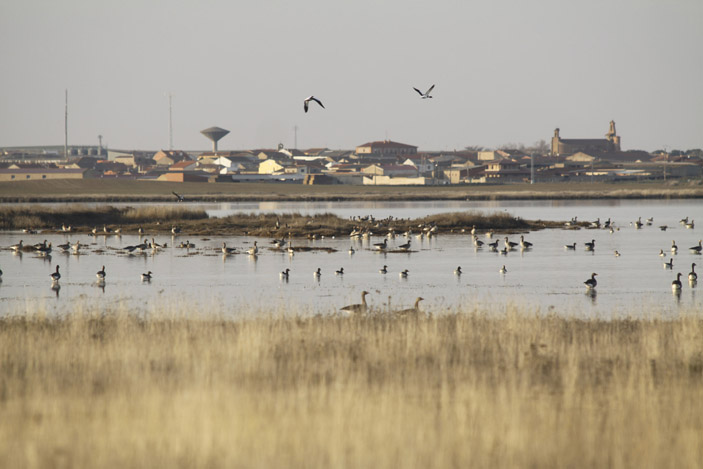
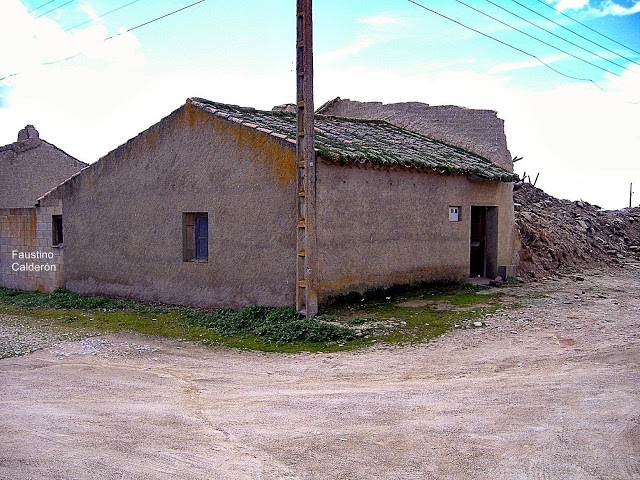
Porfirio´s house, Otero de Sariegos (Zamora)
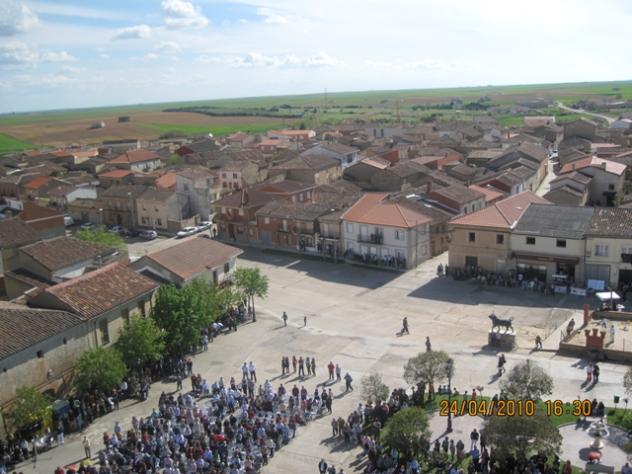
Villarrin de Campos (Zamora)
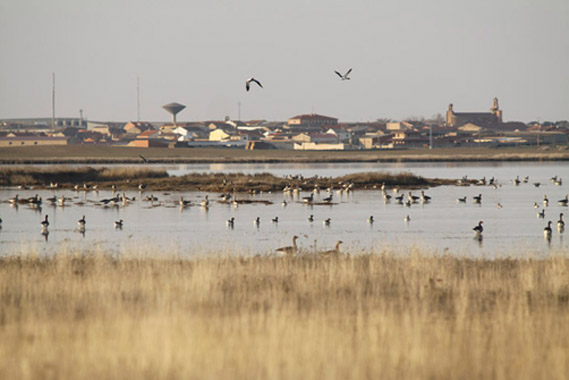
A view of Villafáfila (Zamora)
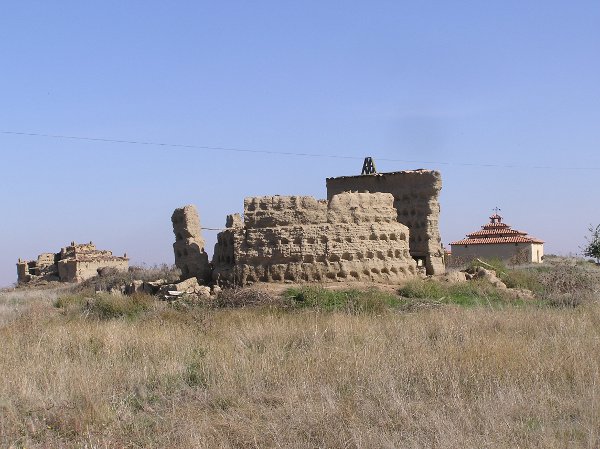
A pigeon loft to criate pigeon chicks in Otero de Sariegos (Zamora)
Well, I hope that you have enjoyed with this article. And I hope that you can visit Spain, in order to can go to this area of Zamora.
Till soon, kind regards,
Luis.
Sponsored by Costaluz Lawyers.
Please click down here:

 0
Like
Published at 12:52 AM Comments (0)
0
Like
Published at 12:52 AM Comments (0)
The names of different types of red meat in Spanish
Monday, April 7, 2014
Here, I bring you a video, where the Chef Sergio Fernández explain you the different types of red meat. Please click down here, on the link:
http://www.rtve.es/television/20140402/carnes-rojas-cortes-usos/909460.shtml
Sergio: “Hellow: I am Sergio Fernández. Welcome to the “Master Chef” School. We start with high back; look that the high back has ribs and does have the food part of meat, but has a part as skirts and a lot more fat ..... Sirloin: a very tender part ; we can do it in so many ways : we can consume it raw --in fact, if we make a steak tartar , the part of the sirloin, is perfect because it does not have any type of nerve-- ……. Here is what would be a "veal loin" or cow and here we would have what would be a pony loin ; but look the difference in meat color ... important .... But look these are muscle ; ie , the muscle contracts and expands in this direction; that is, never in life I will make a cut along well , because then I will do whole muscle that I put in my mouth .... The tail is a very sinewy meat, it is much, much nerve ...... Hindquarter, middle (high loin, sirloin , tenderloin, breast and entails) and here is what we would have forehand: they are beef tendon; but, if we respect the cooking times and proper technique, we get always make good dishes”
I hope that now you can choose the meat, if you did not know it before --and especially to come to eat in Andalusia--.
Till soon, kind regards,
Luis.
Sponsored by Costaluz Lawyers.
Please click down here:

 0
Like
Published at 2:57 PM Comments (0)
0
Like
Published at 2:57 PM Comments (0)
The miracle of stem cells in Spain
Saturday, April 5, 2014
-Today I want to share with you a very important chapter of the Television program "Comando Actualidad" about stem cells.
The use of stem cells is very important, since it is a natural method, no side effects, but still is experimental efficiency, are already getting some progress. And today I want to show you some of them, with this video. Please click below:
http://www.rtve.es/alacarta/videos/comando-actualidad/comando-actualidad-agarrados-ciencia-terapias-avanzadas/2485961/
Silvia Sánchez: “The research in advanced therapies is, according to experts, the future of Medicine, which is to create drugs with cells and tissues of the patient himself. Andalusia, with 22 clinical trials underway, led this research”……………………………
………………………………………..
Silvia: “May I get in?. Good morning, How are you, Mary?”
Mary: “Very well”
Silvia: “What will they make you?”
Mary: “Right now, I am going down to the surgery, they will extract blood blood to extract stem cells ....”
Silvia: “You are diabetic”
Mary: “Yes”
Silvia: “The problem is that it does not circulate blood well. And what will happen when they put the cells, which have been removed from .... "
Mary: “But, the arteries leave them as a "little children", therefore they are called stem cells, and these "children" are those that improve circulation. Formerly, many people would coraban feet cause of diabetes. And putting this one to me, there is the half possibility to happen that”
Silvia: “Dr. Herrera: You are the Director of the Unit of Cellular Therapy of the “Reina Sofía Hospital”, in Córdoba. What will you do today with Maria?”
Dr. Herrera: “Well, first, we are going to remove the patient's bone marrow, which is that we will then use for her treatment”
Silvia: “The same patient is cured with his own body”
Dr. Herrera: “Really. Under European law, the cells are drug. It is the window of Regenerative Medicine”
Silvia: “That is the famous bone marrow”
Dr. Herrera: “That is the bone marrow….; many people confuse it with spinal cord ....”
Silvia: “bone marrow is removed from the bone”
Dr. Herrera: “bone marrow is removed from the bone”
Silvia: “How much bone marrow have we?”
Dr. Herrera: “Uhhh, so very much….Always, in Clinical Research, it begins at instances, of course, that they have no solution. So this is a patient in that there is no kind of solution. The rate of leg amputations in these patients is so high. And, as we are convinced that they will benefit from treatment, we request authorization from the Medicines Agency and Ethics Committees and we are allowed with the "compassionate use"”
Silvia: “And the compassionate use is….”
Dr. Herrera: “It is to use the same treatment than we should do in a clinical trial, but out of the clinical trial and in a manner that can not be used clinically normal, because we have not yet completed the pilot phase”
Silvia: “Here the Maria´s bone marrow goes”
Dr. Herrera: “Here the Maria´s bone marrow goes, which we are going to carry to the laboratory for processing it and, in two or three hours, we will have prepared it to be able to put it to Mary ..... Shot, here you have it..... well ..... Take care of it”
Silvia: “This is the machine that will separate what is useful than what is not useful”
Dr. Herrera: “It is so”
Silvia: “It is like creating drugs a la carte”
Dr. Herrera: “Yes, yes”
Silvia: “So I have heard ... it seems the panacea; but I still understand that you have to be cautious”
Dr. Herrera: “Very cautious. We have shown, for sure, that the procedure is safe, ie, it has no side effects; but we have not shown, yet, the effectiveness, we have indications of effectiveness. The biomedical research is very expensive; however, I think it is an investment,it is not an expense. If we can show that we can prevent the amputation of a leg, the process will be much cheaper than all the functional recovery: the prosthesis and all, only in economic terms”.
Silvia: “It has been four hours since they extracted a part of her bone marrow to Mary. Now is the time to transfer the cells have reached to her veins”
Anesthetist: “This is for you to stay a little more quiet, All right?”
Silvia: “Those are the cells of Mary herself, now you are going to infuse”
Anesthetist: “This is .. the arteries, which are theoretically well, and what we are releasing the cells from the knee so that the knee down, begin to form new vessels”
Nurse: “Do not force, do not force…”
Anesthetist: “Still leave it the arm”
Silvia: “Antonio Chacón: you are the cardiovascular doctor, who has treated and treats María del Valle, during this time, and who has convinced to undergo this test”
Dr. Chacón: “We have managed to keep her legs and her mobility, all this time, and we also have an option for the future. Within a few months, she will have some new arteries in her legs”
…………………………………..
Silvia: “What is not a few thing………………”
Dr. Chacón: “It is essential ... that is a Spanish pure research ... Right now, our series, the series that we have in our hospital is the most important worldwide; we have over a hundred cases made by a route, which is the first to be made and this has made us to share this experience with other countries and right now that is the story”
Anesthetist: “We have done the infusion and we can only compress. So be quiet, that we ended”
Silvia: “Stem cells also are being used to treat heart attacks: in 2002, in this hospital there was the first transfusion of cells from one patient to his infarcted heart”
………………………………………………….
Silvia: “Doctor Suárez de Lezo: you were the doctor who transferred stem cells to the heart of Manuel, in the year 2007”
Dr. Suarez de Lezo: “Yes”
Silvia: “How is he?”
Dr. Suarez de Lezo: “But, we are now doing a routine scan, but its evolution has been really good”
Silvia: “How are you, Manuel?”
Manuel: “Me?, stupendously”
Silvia: “¡Yes?!”
Silvia: “Are you all right?”
Manuel: “Yes”
Silvia: “A case like Manuel makes you have data for further research?”
Dr. Suarez de Lezo: “Of course. Of course….Manuel confirmed the findings that we had in a previous study”
Silvia: “You confirm that the stem cells work”
Dr. Suarez de Lezo: “They work, although we do not know how they do it. However,….ffffff.. State agencies follow asking a lot level of demand in the knowledge”
Silvia: “Why?”
Dr. Suarez de Lezo: “But I do not know….That is the problem”
Silvia: “Are there economic interests behind?”
Dr. Suarez de Lezo: “What happens: a drug that the own patient has is good for the Pharmaceutical Industry?....What do you think about this question?”
…………………………………………
Dr. Suarez de Lezo: “The tension is good: you have 13,8”
Well, here the video finished.
I hope this method can help many people all over the world and I also hope that all Goverments can give much money for research.
Till soon, kind regards,
Luis.
Sponsored by Costaluz Lawyers.
Please click down here:

 0
Like
Published at 3:32 PM Comments (0)
0
Like
Published at 3:32 PM Comments (0)
Selling a very nice farm in southern Spain
Friday, April 4, 2014
Two days ago I have just seen a new that payed my attention: The farm “The Almoraima” is on sale. Then, I remembered a post that I published about The Almoraima in 2009. I looked for it and, when I found it, I could see that it was without pictures; I remember that over those days, Eye On Spain had any trouble with the website; surely therefore my pictures were disappeared; but I do not know what happened.
Then, by the way of this new of the sale of La Almoraima, I want to show you that post, but with those pictures, that were disappeared. This is the post, please click down here:
http://www.rtve.es/alacarta/videos/repor/repor-isabel-ugalde/2454189/
Here you have the translation:
Isabel Ugalde (The Manager of The Almoraima) explains the terms of the sale of this famous farm:
Isabel: “The estate has a famous reserve, privately owned reserve of the Almoraima is famous; but you are who have put us on the market ….; that is the good part of the Mass Media sometimes. The first article in El Pais, the first one that was done, brought itself to a lot of people who called and things, that you the Mass Media do, attract people. There is much focus placed in Spain,right now, on investment level, almost excessive; people I know, who are in the world of investment banking, are almost afraid of wanting there to buy Spain, whatever --and buy Spain is to buy everything: from businesses to Funds until pieces .... No, it is that it is cheap (Spain), is that it is cheap, it is not for sale, it is that it is cheap and someone to put an attractive thing it is hard to resist, Is not it?”.
Well, and now I am going to give you the link of the post, that I published in 2009. Please click down here:
http://www.eyeonspain.com/blogs/luislopezcortijo/896/the-house-of-the-almoraima.aspx
I hope that you have liked this new post.
Till soon, kind regards,
Luis.
Sponsored by Costaluz Lawyers.
Please click down here:

 0
Like
Published at 11:47 AM Comments (0)
0
Like
Published at 11:47 AM Comments (0)
Origin of Democracy and Monarchy in Spanish
Tuesday, April 1, 2014
Due to the recent death of Adolfo Suarez, who was President of Spain, between 1976 and 1981, in the last few weeks, in Spain, we have been talking about this very important character, in our History, who managed to achieve consensus and life in peace among the Spaniards of different ideologies.
Suárez was one of the architects of the Transition from Dictatorship to Democracy. And that is precisely what I want to talk about today: Democracy, its origin.
In “The Philippics”, Cicero condemned the attempt by Marco Antonio of stablishing a Dictatorship in Roma. And it here begins the important role of Democracy: that is the antithesis of the Dictatorship, because it defends the value of freedom, among others.
Democracy comes from the Greek --Democratia, that comes from the words: demos (people) and kratos (power)--.
A Spanish word related to Democracy is Demographics (the study about people).
The party of no government is an Ácrata (Anarchist).
At the same time we have the word “Anarquía”, we have the word “Monarquía” (Monarchy), that comes from: Mono (only one) and Argi or Argia (Government). About the word “Mono”, we have in Spanish: Monoplaza (single-seater), Monoteista (who believes in only one god).
Same that Monarchy, we have: “Architect” and “Archipielago” (a set of islands).
The opposite of Democracy is Dictatorship, that comes from Dictare (to say often). Dictate).
In Spain we had a “Tansition”, that comes from “Transitio”, in Latin, that comes from the words: “Trans” and “Itio”, that means “To go”; so, it is the action of “To pass”. And from there comes the word “Tánsito” (Transit); also the word: “Transeunte” (Passerby).
Transition took a change of Regime. This word comes from the verb Rego, Regis, Regere, Rexi, Rectum, that means Govern, Manage, Govern. Hence comes King, Ruler, Rector, Law. A Regime is a set of rules than we have as a Society.
Well, I hope that you have enjoyed with this post.
Till soon, kind regards,
Luis.
Sponsored by Costaluz Lawyers.
Please click down here:

 0
Like
Published at 11:24 PM Comments (0)
0
Like
Published at 11:24 PM Comments (0)
Spam post or Abuse? Please let us know
|
|